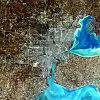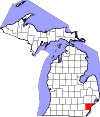- Ford River Rouge Complex
-
Rouge Plant redirects here. It may also refer to the subshrub Rivina humilisFord River Rouge Complex
 Aerial view of the Rouge Complex in 1927
Aerial view of the Rouge Complex in 1927Location: Dearborn, Michigan Built: 1917 - 1928 Architect: Albert Kahn Governing body: Private NRHP Reference#: 78001516 Significant dates Added to NRHP: June 2, 1978[1] Designated NHLD: June 2, 1978[2] The Ford River Rouge Complex (commonly known as the Rouge Complex or just The Rouge) is a Ford Motor Company automobile factory complex located in Dearborn, Michigan, along the Rouge River, upstream from its confluence with the Detroit River at Zug Island. Construction began in 1917, and when it was completed in 1928 it had become the largest integrated factory in the world.
Contents
Structure
The Rouge measures 1.5 miles (2.4 km) wide by 1 mile (1.6 km) long, including 93 buildings with nearly 16 million square feet (1.5 km²) of factory floor space. With its own docks in the dredged Rouge River, 100 miles (160 km) of interior railroad track, its own electricity plant, and ore processing, the titanic Rouge was able to turn raw materials into running vehicles within this single complex, a prime example of vertical-integration production. Over 100,000 workers were employed there in the 1930s.
Some of the Rouge buildings were designed by Albert Kahn. His Rouge glass plant was regarded at the time as an exemplary and humane factory building, with its ample natural light coming through windows in the ceiling. More recently, several buildings have been converted to "green" structures with a number of environmentally friendly features. However, many vehicular skeletons remain buried on the grounds of the Rouge.
In the summer of 1932, through Edsel Ford's support, Diego Rivera studied the facilities at the Rouge; these studies became a major part of his set of murals Detroit Industry, on continuous display at the Detroit Institute of Arts since their completion in 1933.
Production
The Rouge's first products were Eagle Boats, World War I anti-submarine warfare boats produced in Building B. The original Building B, a three-story structure, is part of the legendary Dearborn Assembly Plant, which started producing Model A's in the late 1920s and continued production through 2004. After the war, production turned to Fordson tractors. Although the Rouge's coke ovens and foundry produced nearly all the parts of the Model T, assembly of that vehicle remained at Highland Park. It was not until 1927 that automobile production began there, with the introduction of the Ford Model A. Later Rouge products included the 1932 Model B, the original Mercury, the Ford Thunderbird, and four decades of Ford Mustangs. The old assembly plant was idled with the construction and launch of a new assembly facility on the Miller Road side of the complex, currently producing Ford F-150 and Lincoln Mark LT pickup trucks.
On May 26, 1937, a group of workers attempting to organize a union at the Rouge were severely beaten, an event later called the Battle of the Overpass. Peter E. Martin's respect for labor led to Walter Reuther, a UAW leader, allowing Martin to be the only Ford manager to retrieve his papers or gain access to the plant.[3]
After the 1960s, Ford began to decentralize manufacturing, building many factories across the country. The Rouge, too, was downsized, with many units (including the famous furnaces and docks) sold off to independent companies.
By 1992, only Mustang production remained at the Dearborn Assembly Plant (DAP). In 1987 Ford planned to replace that car with the front wheel drive Ford Probe, but public outcry quickly turned to surging sales. With the fourth-generation Mustang a success, the Rouge was saved as well. Ford decided to modernize its operations and built a new power plant to replace the original one, in which a gas explosion on February 1, 1999, killed six employees and injured two dozen more.
As it ended production, Dearborn Assembly Plant (DAP) was one of six plants within the Ford Rouge Center. The plant was open from 1918 to May 10, 2004 with a red convertible 2004 Ford Mustang GT being the last vehicle built at the historic site. Demolition of the historic DAP facility was completed in 2008. All that remains is a 3000 place parking lot to hold light truck production from the new Dearborn Assembly Plant.
Ford Rouge Center
Today, the Rouge site is home to Ford's Rouge Center. This industrial park includes six Ford factories on 600 acres (2.4 km²) of land, as well as steelmaking operations run by Severstal North America, a Russian steelmaker. The new Dearborn Truck factory famously features a vegetation-covered roof and rainwater reclamation system designed by sustainability architect William McDonough. This facility is still Ford's largest factory and employs some 6,000 workers. Mustang production, however, has moved to the AutoAlliance International plant in Flat Rock, Michigan.
Tours of the factory were a long tradition. Tours of the facility began in 1924 and ran until 1980. They resumed in 2004 in cooperation with The Henry Ford Museum with multimedia presentations as well as viewing of the assembly floor.
The management of Dearborn Truck has decreed that no vehicles from other manufacturers may park in the main employee lot. A sign proclaims "Ford family vehicles only." Hourly workers from both Ford and Severstal facilities at the complex are represented by UAW Local 600.
Ford's SS William Clay Ford was based out of the River Rouge Plant.
Renovated architecture
In 1999 Architect William McDonough entered into an agreement with Ford Motor Company to redesign its 85-year-old, 1,212-acre (490 ha) Rouge River facility.[4] The roof of the 1.1 million square foot (100,000 m2) Dearborn truck assembly plant was covered with more than 10 acres (4.0 ha) of sedum, a low-growing groundcover. The sedum retains and cleanses rainwater and moderates the internal temperature of the building, saving energy.
The roof is part of an $18 million rainwater treatment system designed to clean 20 billion U.S. gallons (76,000,000 m3) of rainwater annually, sparing Ford from a $50 million mechanical treatment facility.[5]
References
- ^ "National Register Information System". National Register of Historic Places. National Park Service. 2007-01-23. http://nrhp.focus.nps.gov/natreg/docs/All_Data.html.
- ^ "Ford River Rouge Complex". National Historic Landmark summary listing. National Park Service. http://tps.cr.nps.gov/nhl/detail.cfm?ResourceId=1760&ResourceType=District. Retrieved 2008-06-27.
- ^ Bryan, Ford: "Henry's Lieutenants", page 214, Wayne State University Press, 1993
- ^ http://www.metropolismag.com/html/content_0801/mcd/
- ^ http://archrecord.construction.com/features/bwarAwards/archives/04b_fordRouge.asp
External links
- Photos from the Rouge Steel mill
- "Big Generator for Auto Plant Adds to Giant Power" Popular Mechanics, September 1937, bottom-left pg 374
Coordinates: 42°18′34″N 83°09′44″W / 42.30941°N 83.16212°W
Metro Detroit Topics Architecture · Culture · Detroit River · Economy · Freeways · History · Historic places · International Riverfront · Lake St. Clair · Media · Music · Parks and beaches · People · Skyscrapers · Sports · Theatre · Tourism · Transportation
Major city Municipalities
over 80,000Canton Township · Clinton Township · Dearborn · Livonia · Sterling Heights · Troy · Warren · WestlandMunicipalities
45,000 to 80,000Dearborn Heights · Farmington Hills · Grosse Pointe · Macomb Township · Novi · Pontiac · Redford Township · Rochester Hills · Royal Oak · St. Clair Shores · Shelby Township · Southfield · Taylor · Waterford Township · West Bloomfield TownshipSatellite cities Counties in MSA Counties in CSA Regions Outlying regions  Michigan ·
Michigan ·  United States
United StatesIndustrial landmarks in metropolitan Detroit City Antietam Avenue Bridge • Cass Motor Sales • Chestnut Street Bridge • Crescent Brass and Pin Company Building • Detroit Edison Company Willis Avenue Station • Dry Dock Complex • Edwin S. George Building • Globe Tobacco Building • Graybar Electric Company Building • Michigan Bell and Western Electric Warehouse • Milwaukee Junction • New Amsterdam Historic District • Stroh River Place (Parke-Davis Plant) • Riverwalk Hotel (Parke-Davis Laboratory) • Piquette Avenue Industrial Historic District • Piquette Plant • Frederic M. Sibley Lumber Company Office Building • Frederick Stearns Building • Russell Industrial Center • Stuber-Stone Building • West Jefferson Avenue – Rouge River Bridge

Suburban Ford River Rouge Complex • Ford Valve Plant • The Henry Ford • Willow Run
See also List of Registered Historic Places in Michigan History of Michigan Timeline Glaciation · Paleo-Indian · Archaic · Woodland · Algonquian · French · British · Territory · State
Native Council of Three Fires · Fox · Kickapoo · Mascouten · Menominee · Miami · Ojibwe (Chippewa) · Odawa (Ottawa) · Potawatomi · Sac (Sauk)
Colonial Fur Trade · Coureurs des Bois · Voyageurs · Iroquois Wars · New France · Detroit · Fox Wars · Fort Michilimackinac · Seven Years' War · Peace of Paris · Pontiac's Rebellion · Royal Proclamation · Indian Reserve · Quebec Act · Revolutionary War · Treaty of Paris
United States MilitaryJay Treaty · Treaty of Saginaw · Treaty of Chicago · Toledo War · Battle of Windsor · Treaty of Fond du Lac · Treaty of La Pointe ·
Civil WarIndustryNorthwest Territory · Chicago Road · Clinton-Kalamazoo Canal · Auto Makers · River Rouge Plant · Willow Run · Ambassador Bridge · Detroit–Windsor Tunnel · Flint Sit-Down Strike · Mackinac Bridge ·
1967 Detroit riotPoliticsU.S. National Register of Historic Places Topics Lists by states Alabama • Alaska • Arizona • Arkansas • California • Colorado • Connecticut • Delaware • Florida • Georgia • Hawaii • Idaho • Illinois • Indiana • Iowa • Kansas • Kentucky • Louisiana • Maine • Maryland • Massachusetts • Michigan • Minnesota • Mississippi • Missouri • Montana • Nebraska • Nevada • New Hampshire • New Jersey • New Mexico • New York • North Carolina • North Dakota • Ohio • Oklahoma • Oregon • Pennsylvania • Rhode Island • South Carolina • South Dakota • Tennessee • Texas • Utah • Vermont • Virginia • Washington • West Virginia • Wisconsin • WyomingLists by territories Lists by associated states Other  Category:National Register of Historic Places •
Category:National Register of Historic Places •  Portal:National Register of Historic Places
Portal:National Register of Historic PlacesNorth America AutoAlliance International • Blue Diamond Truck • Chicago Assembly • Cuautitlán Assembly • Dearborn Truck • Ford River Rouge Complex • Hermosillo Stamping & Assembly • Kansas City Assembly • Kentucky Truck Assembly • Louisville Assembly Plant • Michigan Assembly Plant • Oakville Assembly • Ohio Assembly • St. Thomas Assembly • Twin Cities Assembly Plant • Wayne Stamping & AssemblyNorth America (former) Atlanta Assembly • Vintage Atlanta Plant • Chester Assembly • Edgewater Assembly • Edison Assembly • Long Beach Assembly • Los Angeles Assembly • Lorain Assembly • Norfolk Assembly • Omaha Assembly • Ontario Truck • Ford Richmond Plant • San Jose Assembly Plant • St. Louis Assembly Plant • Wixom Assembly PlantFord of Europe Automobile Craiova • Cologne Body & Assembly • Ford Otosan Assembly • Saarlouis Body & Assembly • Valencia Body & Assembly • Cork Assembly (closed) • Dagenham Assembly (closed)Others Broadmeadows Assembly (Australia) • Ford Motor Company PhilippinesList of Ford factories Categories:- Historic districts in Michigan
- Ford factories
- National Historic Landmarks in Michigan
- Motor vehicle assembly plants in Michigan
- 1917 architecture
- Buildings and structures in Dearborn, Michigan
Wikimedia Foundation. 2010.


